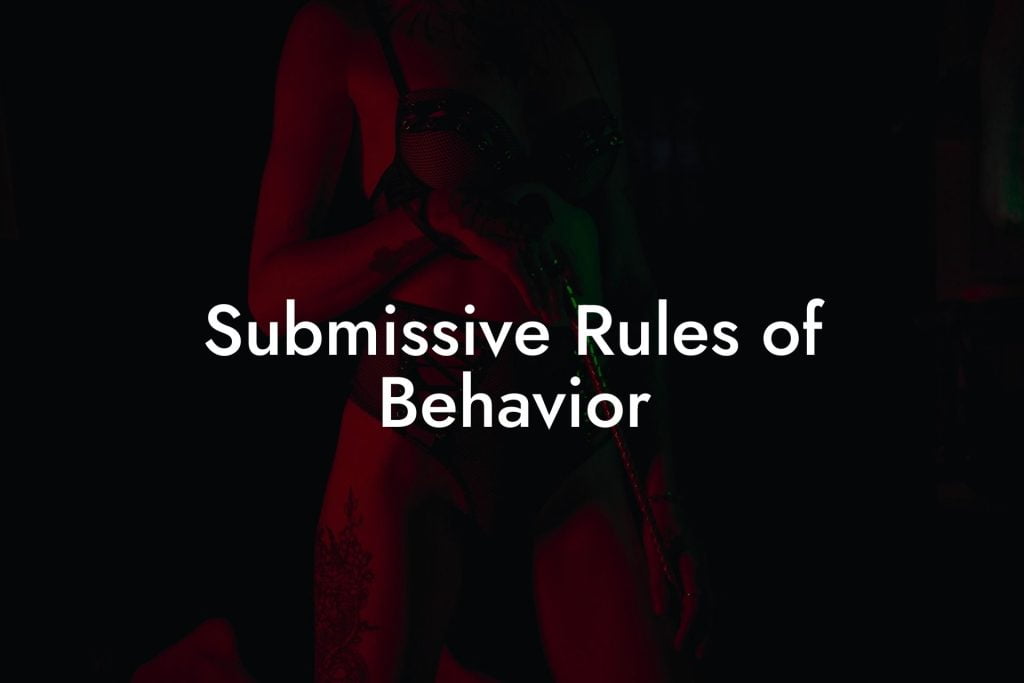When entering the BDSM world, it's crucial to establish clear rules and expectations for both dominants and submissives. In a Dom/sub (Dominant/submissive) relationship, the dominant partner takes control while the submissive partner willingly surrenders power. This article aims to outline the essential Dom rules for subs, emphasizing effective communication, consent, and boundary-setting. Whether you're new to BDSM or seeking to enhance your existing dynamic, these guidelines will help foster a fulfilling and safe relationship.
In any BDSM relationship, consent is the cornerstone of trust and respect. It’s more than just saying “yes” or “no”—it’s about openly communicating your desires, limits, and expectations. But trust doesn’t end with a conversation—it’s built through ongoing, clear agreements. That’s where our Dominant & Submissive BDSM Contract Pack comes in. Find out more →
Establishing Communication
One of the most important Dom rules is to establish open and honest communication with your sub. This creates a safe space for both partners to express their needs, desires, and limits. Regular check-ins are crucial to ensure both parties feel heard and understood. It's essential for the dominant to actively listen and validate the submissive's experiences and emotions.
Consent and Boundaries
Consent is the bedrock of any BDSM relationship. It's vital for both the dominant and the submissive to clearly communicate their boundaries and establish a safe word or signal. Dom rules necessitate respecting these boundaries at all times. Consent should be enthusiastic, ongoing, and can be withdrawn at any point during a scene. Consensual non-consent (CNC) can be explored within agreed-upon limits, ensuring the submissive's emotional well-being and physical safety.
Power Exchange Dynamics
In a Dom/sub relationship, power exchange dynamics play a central role. Dom rules emphasize the responsible use of power and authority. It's essential for the dominant to understand the responsibility they hold in providing guidance, structure, and discipline, while always prioritizing the well-being and consent of the submissive. Mutual trust and respect are key elements that contribute to a healthy power dynamic.
Rituals and Protocols
Dom rules often include the establishment of rituals and protocols to reinforce the power dynamic. These can be simple actions or behaviors that symbolize the Dominant's authority and the submissive's devotion. For example, the submissive may be required to address the Dominant using specific titles or follow a set of rules regarding their appearance or behavior. Rituals and protocols should be discussed and negotiated to ensure both partners find them meaningful and fulfilling.
Looking for the best BDSM & Kink OnlyFans content creators? Here is a list of of our favourites that you will love:
-
- Best BDSM & Fetish OnlyFans - Molly✨ >> Link
- Best BBW & Huge Ass OnlyFans - Naughty Hanna Zimmer 💜🎀 >> Link
- Best Sexy Gaming Nerd OnlyFans - 🎮 Gracy EstuSWEET 🎮 >> Link
- Best Fetish & Kink Messaging OnlyFans - 💫Lola La Fleur 💫 >> Link
- Best Girl Next Door OnlyFans - ☀️Lily ⛅ >> Link
- Best Tiny European OnlyFans - 💝 Ami Allison 💝 >> Link
- Best Cosplay OnlyFans - 🐱 Little Kitty Kate 👉👌 >> Link
- Best Little OnlyFans - 🧸 Katya 🙇♀️ Sun >> Link
- Best Sub OnlyFans - 🍌Hanna Banana🍌 >> Link
- Best Teen & Huge Tits OnlyFans - ❣️Anny❣️19 y.o. BUSTY student girl >> Link
- Best Tiny Tits OnlyFans - ⍣⭐️ Sofia Parker ⭐️⍣ >> Link
- Best Sub & Huge Boobs OnlyFans - Nika Huge Boobs >> Link
- Best Kink OnlyFans - Sofia💖 >> Link
- Best Fetish & Girl Next Door OnlyFans - Hillary is Wet 💦 >> Link
- Best Dirty Latina OnlyFans - Paula Flores 😈 >> Link
Not quite what you are looking for? View the full list →
Frequently Asked Questions
What is a BDSM contract?
A BDSM contract is a written agreement between individuals participating in BDSM activities. It outlines the roles, responsibilities, limits, and expectations of each party. It helps to establish clear communication and consent, ensuring that all participants understand the nature of their relationship and the scenes they will engage in.
Are BDSM contracts legally binding?
No, BDSM contracts are not legally binding documents. They are a tool for communication and mutual understanding within the BDSM community and are not enforceable by law. However, they do represent a consensual agreement between adults and can help clarify the intent and scope of the relationship.
What are the basics of BDSM power dynamics?
The basics of BDSM power dynamics involve a consensual and negotiated exchange of power between a dominant (dom/domme) and a submissive (sub). There are many variations and roles within these dynamics, such as "switches" who may alternate between dominant and submissive roles, and they can be as fluid or structured as the participants decide.
How important is consent in a BDSM context?
Consent is the cornerstone of ethical BDSM practices. All activities should be based on the clear, informed, and voluntary agreement of all participants. Consent must be given without coercion, and all parties should have the freedom and capacity to withdraw consent at any point.
What should a BDSM contract include?
A BDSM contract should include the names of the parties involved, the duration of the agreement, privacy and discretion clauses, agreed-upon activities, hard and soft limits, safe words, and any protocols or rituals. It should also cover health and safety considerations and how to handle conflicts or breaches of the contract.
Can a BDSM contract be changed?
Yes, a BDSM contract can be modified with the consent of all parties involved. It is a living document that reflects the evolving nature of the relationship. Changes should be discussed openly and consensually, and the revised terms should be added to the contract.
What are safe words and why are they important?
Safe words are predetermined words or signals used during BDSM play to communicate the need to slow down, check-in, or stop an activity immediately. They are crucial for maintaining the safety and well-being of participants, ensuring that play does not exceed anyone's boundaries or comfort levels.
How can BDSM activities be conducted safely?
BDSM activities can be conducted safely by thoroughly discussing and agreeing upon activities and boundaries before engaging, using safe words, routinely checking in with each other during play, having safety equipment on hand, and being aware of each other’s physical and emotional limits. Education, communication, and mutual respect are key.
Is a BDSM contract required to engage in BDSM activities?
A BDSM contract is not a requirement, but it is a valuable tool for some participants. It helps to communicate and document the mutual understanding of the relationship and scenes. Whether or not to have a contract is a personal choice that should be respected by all parties involved.
What does ‘aftercare’ mean in the context of BDSM?
Aftercare refers to the period of attention and care that follows a BDSM scene. It can involve physical care, such as tending to any marks or providing warmth, as well as emotional care, like cuddling, affirmation, and debriefing the scene. Aftercare helps participants transition back to their regular headspace and ensures their well-being.
How do trust and communication factor into BDSM relationships?
Trust and communication are essential components of BDSM relationships. Trust is built over time and allows participants to feel safe exploring their desires and limits. Effective communication ensures that activities are consensual and that all parties remain on the same page regarding expectations and boundaries.
How do you negotiate a BDSM scene?
Negotiating a BDSM scene involves open and honest discussion about what activities are desired, what boundaries exist, the use of safe words, and aftercare needs. It's crucial to be clear about what you're comfortable with and to listen to and respect the other person's limits and expectations.
Can anyone participate in BDSM?
Anyone who is of legal age and has the capacity to give informed consent can participate in BDSM activities. It is important for participants to be self-aware and to have a good understanding of their own needs, desires, and limits, as well as those of their partners.
Is BDSM therapy?
BDSM is not a form of therapy. While it can be a positive and affirming experience for many, giving individuals space to explore their sexuality, it should not be used as a substitute for professional psychological help if needed.
Can BDSM practices change over time?
Yes, BDSM practices and dynamics can change over time as individuals explore, grow, and change their interests and boundaries. It's essential to maintain open communication to adapt the relationship and activities accordingly.
What is a 'scene' in BDSM?
A 'scene' in BDSM is a specific period where participants engage in BDSM activities. A scene has a start and end point, and involves pre-negotiated actions and roles. It may be part of a one-time event or a longer-term dynamic.
What if something goes wrong during a BDSM activity?
If something goes wrong, participants should use their agreed-upon safe words or signals to pause or stop the activity. Open communication is vital in addressing what happened and ensuring everyone's well-being. Learning from the experience is important for future play.
How do you care for someone experiencing 'sub drop' or 'dom drop'?
'Sub drop' and 'dom drop' refer to the feeling of physical or emotional exhaustion that can sometimes occur after intense scenes. Caring for someone experiencing drop involves offering support and comfort, providing aftercare, and discussing their feelings. It’s important to monitor the individual's condition and provide the care they need to recover.
How confidential are BDSM contracts and activities?
BDSM contracts often contain clauses around confidentiality to protect the privacy of all parties involved. The level of discretion should be agreed upon before entering into a contract or engagement, with clear guidelines on what can be shared and with whom.
Are there any risks associated with BDSM?
There are physical and emotional risks associated with BDSM, as with any sexual activity. These can be mitigated by practicing risk-aware consensual kink (RACK) or safe, sane, and consensual (SSC) BDSM, using safe words, respecting boundaries, and engaging in thorough pre-scene negotiations and aftercare.
Where can one learn more about BDSM safety and practices?
One can learn more about BDSM safety and practices by reading educational materials, attending workshops, joining community groups, discussing with experienced practitioners, and utilizing reputable online resources. Continuous learning and open-mindedness are important for a safe and fulfilling experience.
As you explore the realms of BDSM and Dom/sub dynamics, remember the crucial importance of effective communication, consent, and boundary-setting. Building trust, respect, and open lines of communication is vital to create a safe and fulfilling D/s relationship. To further enhance your journey, order our Ultimate BDSM Contract Pack for comprehensive guidelines and explore other informative guides on Filthy Adult. Don't forget to indulge your kink desires in our fetish shop, where you'll find a diverse range of curated items designed for lovers of erotic art and BDSM. Share this article with others who might benefit from this information and embrace the potential of the BDSM and kink world.













